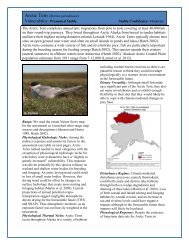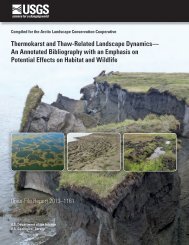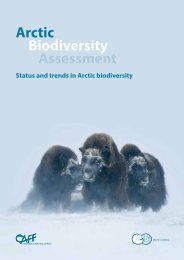Assessing Climate Change Vulnerability of Breeding Birds in Arctic ...
Assessing Climate Change Vulnerability of Breeding Birds in Arctic ...
Assessing Climate Change Vulnerability of Breeding Birds in Arctic ...
Create successful ePaper yourself
Turn your PDF publications into a flip-book with our unique Google optimized e-Paper software.
We chose to use the 2-m overlay <strong>in</strong> thevulnerability assessment as a plausiblefuture to capture the potentially importantimpacts <strong>of</strong> sea level rise for species withcoastally limited distributions. The 2-meterdata shifted the sea-level rise score from“neutral” to “slightly <strong>in</strong>creasedvulnerability” for 7 <strong>of</strong> the 54 species.Sensitivity survey and expert solicitationWe asked <strong>in</strong>dividual species experts to scorethe sensitivity factors <strong>of</strong> the CCVI (13 <strong>of</strong> 23;see Fig 2.2.). Some factors have subcategories,and others require a geospatialoverlay to assess. Most species experts wereagency, academic, non-governmental, orprivate <strong>in</strong>dustry scientists with advanceddegrees that have spent multiple yearsstudy<strong>in</strong>g some aspect <strong>of</strong> their focal speciesand were familiar with the respective body<strong>of</strong> literature. We solicited responses from 83species experts <strong>of</strong> which 51 responded bycomplet<strong>in</strong>g sensitivity surveys and provid<strong>in</strong>g<strong>in</strong>formation on one measure <strong>of</strong> <strong>in</strong>directclimate exposure – “human climatemitigation” (Appendix C). The sensitivitysurveys were based on those used <strong>in</strong> avulnerability assessment conducted <strong>in</strong> theState <strong>of</strong> Florida us<strong>in</strong>g the CCVI (Dubois etal. 2011).Experts were <strong>in</strong>structed to respond toquestions taken verbatim from the CCVIguidance document, provide citations andwritten justifications for their responses, andassign a “confidence level” to their responseus<strong>in</strong>g a 1-5 scale. Sensitivity surveyresponses were entered <strong>in</strong>to the CCVI andrun with the various climate exposure andother geospatial <strong>in</strong>puts to generateprelim<strong>in</strong>ary climate change vulnerabilityresults for the 54 species.We presented prelim<strong>in</strong>ary results (notreported here) dur<strong>in</strong>g a workshop <strong>in</strong>Anchorage, Alaska on December 7-9 th ,2011. The 31 participants represented amajority <strong>of</strong> the species’ experts whoreturned a sensitivity survey. It becameclear; both <strong>in</strong> read<strong>in</strong>g survey responses andthrough discussions at the workshop, that<strong>in</strong>dividual experts <strong>in</strong>terpreted somequestions differently. In addition, expertsexpressed some discomfort <strong>in</strong> answer<strong>in</strong>gsensitivity questions that also required someunderstand<strong>in</strong>g and/or speculation aboutclimate exposure and ecosystem responses.To address these issues, a sub-group <strong>of</strong>six avian experts (Appendix D) and WCSclimate change program staff revised theproblematic sensitivity factor questions afterthe workshop and re-evaluated the orig<strong>in</strong>alresponses <strong>of</strong> the larger expert group <strong>in</strong> light<strong>of</strong> this agreed upon language andstandardized <strong>in</strong>terpretation (Appendix F).The orig<strong>in</strong>al responses and support<strong>in</strong>g<strong>in</strong>formation provided by species expertswere circulated to the sub-group and weasked all six experts to revise the orig<strong>in</strong>alresponses on their own. We then met as agroup to discuss any suggested changes tothe orig<strong>in</strong>al scores and to explore anywith<strong>in</strong>-group differences <strong>in</strong> the revisedresponses. We did not strive to reachconsensus, but sought to ensure that relevantnuances <strong>in</strong> reason<strong>in</strong>g were recorded andquestion <strong>in</strong>terpretation was consistent.Because the CCVI can accommodatemultiple scores for any one factor, all <strong>of</strong> there-evaluated responses were used togenerate the revised vulnerabilityassessment results.Visualiz<strong>in</strong>g species sensitivity and climatechange vulnerabilityWe illustrate similarities and differencesbetween the sensitivities and climate changevulnerabilities <strong>of</strong> the 54 bird species with apr<strong>in</strong>ciple components analysis (PCA) basedon a variance-covariance matrix (because <strong>of</strong>the standard scale <strong>of</strong> the variables) andEuclidean distance measure us<strong>in</strong>g PASTs<strong>of</strong>tware (Hammer et al. 2001). While not anideal multivariate method for categorical16








